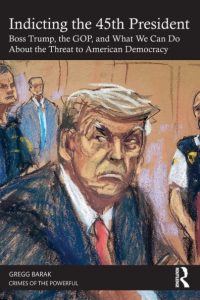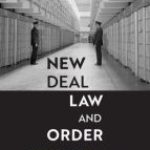Indicting the 45th President: Boss Trump, the GOP, and What We Can Do About the Threat to American Democracy
 Author: Gregg Barak
Author: Gregg Barak
Publisher: Routledge, 2024. 374 pages.
Reviewer: Dawn Rothe | September 2024
Gregg Barak’s Indicting the 45th President is a brilliant insightful, compelling sequel to Criminology on Trump (2022) that meticulously critiques Trump’s criminality, abuse of power, deceptions, false narratives, and divisiveness for starters.
Beginning with the Preface, Trump’s sordid habitual offending and lack of accountability, which date back to the 1970s through today, are succinctly unmasked and given context within the broader structure of a flawed United States political and judicial system, where high-level officials are not held to the same standard of accountability as the majority of the population. This beautifully sets the stage for the final part of this volume’s concluding chapters and suggested reforms. The monograph is divided into three sections, that weave a critical analysis and narrative that extends beyond Trump’s cons and crimes, exposing how a “tyranny of a minority” has resulted in our current crisis of democracy.
The Introduction, Defending Crimes, Incendiary Rhetoric, and the Big Lie, sets the stage while providing the links between the Preface and the rest of the forthcoming chapters chronicling of Trump’s habitual offending, manufacturing of conspiracy theories and mistrust, lies, disinformation, and divisiveness. Beginning with the “Big Lie” – the election was stolen from him, misleading millions of United States citizens, Trump took to messaging his own story that relied on aggressive, accusatory, false accusations and claims defending his lies and rightful claim of the podium of the presidency. All the while lies built upon lies as he publicly maintained, just as he did during his two impeachments and the Russian investigation, were fake news, hoaxes, a democratic witch hunt, devils, and the deep state coming after him. Trump was not alone in perpetuating these lies, as his allies and most Republican leaders continued to defend him, often repeating his lies. Beyond defending Trump, some of the most toxic republican supporters and believers in Trump’s incendiary, violent, discriminatory, misogynistic views became politically goal-oriented. As Barak notes “299 GOP election deniers were running for national, state, and local offices” during the 2022 midterms (p. 8). Anyone who did challenge his lies and manufactured story was demonized, and at times, victimized by MAGA supporters and conspiracy theory swallowers. Trump’s defense of his “Big Lie” included filing lawsuits against those trying to demystify his ‘story’. In short, Trump’s rhetoric fueled the polarization, mistrust, and othering across the United States. Trump had mastered how to tap into the long history of white nationalism, and insecurities, opening the spigot to its wide flow, resulting in even more anger, hatred, and conspiracies.
Part I, An Absence of Bipartisanism, is composed of four chapters. Chapter one details the use of misinformation, conspiracy theories, Trump and his GOP ally’s duplicity, and fraudulent claims of an election plagued by voting misconduct to the ‘stolen election’. Beginning with the litigation seeking accountability for the smears, lies, and false election narrative, spanning individuals and media outlets, including the Dominion Voting Systems lawsuit, the stage is well set by Barak to delve deeper into the vast lies, disinformation, memes, defamation and conspiracies surrounding the era of “post-truth America” and Donald Trump. Following this chapter two goes further by delving into how the politics of scaremongering, scapegoating, and intimidation propagated not just by Trump, but also by political parties, politicians, and government agencies have been used throughout the United States’ history, dating back to Emancipation, the Depression, to the McCarthy era where law has and is weaponized against the marginalized in what Barak refers to as grievance politics. When one considers this with the ballooning of political spending on federal elections, the increasing role and investments of super PACs – political action committees, a surreal, dismal, and dystopic reality of the crisis of the United States electoral processes emerges that continues to play out to date.
Chapter three revolves around corruption, money laundering, and global and offshore capital investments to avoid paying taxes including those of Trump and his family, notably Jared Kushner, to Trump’s fraudulent taxes. Barak details how the “Racketeer in Chief” established from top to bottom an administration manifested in self-interests, profiteering, and corruption rather than for the public good. Thus, committing both occupational and organizational crimes. Moreover, Barak demonstrates how Trump, from the onset of his presidency, was able to reinvent and reinvigorate a culture of favor-seeking, pay-to-play, lobbying, and loyalty. Pivoting, the final chapter of Part I includes assessing the in-depth complexities of the House Select Committee’s investigation, hearing, and findings detailing Trump’s disregard for law and the rules of a democratic election in his effort to overturn the election results and maintain his golden podium as President of the United States. Barak poignantly points out the connection to Trump as a con man and his efforts to stop the peaceful transfer of the presidency with his ability to get his MAGA followers to believe the election was stolen and garner their support and willingness to storm the Capital. “What makes Trump a master con and performer artist is his uncanny ability to get most everyone around him to believe in and/or to go along with the unadulterated nonsense that he is forever propagating no matter how absurd” (p. 134).
Part II, Indicting Donald Trump for Vandalizing the Federal Republic, consists of four chapters highlighting the numerous lawsuits against Trump, the vast criminal charges, and the legal strategies used to hold him accountable. The People of the State of New York v. Donad J, Trump (chapter five) with charges for crimes he committed, before and during his presidency including falsifying business records to defraud and intent to commit other crimes such as repeated violations of campaign election laws, tax laws, aiding and concealing the offenses through the records of the Trump Organization. Barak further unpacks the Manhattan indictment of Trump’s hush money payments to suppress his two extramarital sexual relationships from becoming public knowledge during his 2016 campaign for president.
Following this, the Mar-a-largo Classified Documents Case, in the Southern District of Florida, and the National Archive and FBI’s attempts to retrieve the missing documents, including those classified as highly secretive and sensitive (chapter six) is robustly and compellingly put forth for readers. Beginning with The Mar-a-Largo Model of Prosecution Memo, written in 2022, that assessed and made a case for charging Trump under federal criminal statutes for six federal crimes for charging Trump related to mishandling government documents, obstruction, false information, and contempt, Barak meticulously critiques the higher bar used for an indictment or prosecution, thus reinforcing the existing bias of the CJ system. As Barak argues,
The only logical conclusion to draw from these practices of extreme punitive leniency or outright non- enforcement of the law when it comes to corporate and state offenders is that their criminal behavior is consistently rewarded, both economically and politically. No individual in US history personifies this kind of class- based and political injustice as much as Donald Trump does (p. 182).
Here again, Barak does not omit scrutiny of Trump’s attempts at redirection and conspiratorial narratives portraying himself as a victim of the deep state’s witch hunt and an innocent honest person. Joining his false portrayals, “Trump-Republican apologists” continued to try to muster public support for him, denying Trump’s illegal personal ‘theft’ of 300 classified documents.
Chapter seven considers nuances of the case of The People of Fulton Country, Georgia v. Donald J. Trump et.al. which has 41 total counts ranging from charges of racketeering, conspiracy, solicitation of violations of the oath of a public officer, false statements, defrauding the state, and forgery to name a few, all of which are the result of Trump’s ‘criminal enterprise’ aimed to overturn the results of the 2020 election in Georgia. Beyond specifics of the cases and legal strategies, Trump’s denials, manufactured self-victimhood, and his capitalization, politically and economically, of his legal troubles are further unpacked. The following chapter further delineates Trump’s conspiracies to overturn the election that led to the assault on the Capital, on January 6th, 2021. Beginning with his associates, lawyers, and others, Barak highlights the wide variety of schemes and ploys to change the outcome of the 2020 election including attempting to use false electoral slates to obstruct the congressional certification. Here again, we are presented with dozens of examples of Trump drawing on claims of victimhood as investigations and indictments against him were surfacing, simultaneously with his primary campaigning and subsequent presidential campaign race, all the while using his claim-making as marketing techniques to scheme his MAGA supporters for contributions to his presidential candidacy.
Part III, Liberty, Justice, and American Democracy, has the final two chapters, bringing together the themes and issues raised in previous chapters, concluding with Barak’s proposed radical reforms needed in this democratic crisis. Chapter nine begins by giving the context of the RICO statutes that have rarely been used in efforts to prosecute white-collar, occupational, or corporate criminals. Rather, just as with the Trump Foundation’s fictional contributions civil and administrative regulations are drawn on to address these violations. The inverse relationship between accountability and social harm and the legal misconceptions and assumptions undergirding the United States criminal justice system is further unpacked. This includes the role of myths surrounding democracy to ‘American’ exceptionalism, and capitalism, in propagating much of what we see playing out in today’s political and cultural spectacle. Wherein alienation and a ‘calcification’ of politics are cemented, further facilitating the patterns of ‘othering’, and partisan politics as seen in the current “cultural war”.
The concluding chapter’s heading sums up nicely the problem of today’s political and democratic spectacle that Barak has succinctly analyzed and presented in the previous chapters and the need to reform our democracy from a Tyranny of a Minority to a Tyranny of a Majority. After summarizing how far off the United States is from the ideals of democracy versus the reality of our current state of democracy, Barak argues that we must add to the Bill of Rights guaranteeing economic rights that include security, healthcare, education, and housing, to reforming the Constitution to become closer to the ideal, a democracy of and for the many. At the onset, he establishes the need for and calls for multiparty democracy as a first step to fixing the polarization, othering, and moving the Country out of the “current zero-sum game of politics”, partisanships, and current “episodic paralysis of governing” (pp. 297-298). This must be accompanied by transforming the current economic arrangements and structure. Barak argues for increasing the number of representatives in the House, adding term limits for judges on the Supreme Court, removing the Electoral College, and limiting public campaigning to 60 days, ending privately funded elections, to reformulate our “uber-capitalism” or neoliberalist economy to start. Barak concludes by offering 31 recommendations to achieve the following 6 overarching strategies: Achieve equality of voice and representation, empower voters, ensure governmental institutions’ responsiveness, build up civic information supporting a common purpose, and create a culture and commitment to a constitutional democracy that would end the tyranny of a minority.
In summary, as with Barak’s published public commentaries, this volume further attests to his ever-enduring dedication and commitment to being a public criminologist, exposing crimes of the powerful and taking the messages beyond the walls of academia. This volume, along with the previous book, details and analyzes the historical and current crimes of Trump and his businesses is a must-read for scholars and students interested in white-collar crime from occupational crimes committed for one’s self-interests and gains to organizational crimes and harms such as corporate and state crime.
Dawn L. Rothe is a Professor of Criminology & Criminal Justice at Florida Atlantic University.


